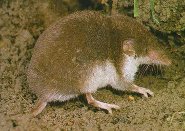 The bicolored shrew (Crocidura leucodon), also known as the white-toothed shrew, is a small mammal known by its distinctive coloring. The bicolored shrew is a medium to dark brown on its back and white or light gray on its underbelly. This difference in color is immediately obvious, as the variation is clearly defined.
The bicolored shrew (Crocidura leucodon), also known as the white-toothed shrew, is a small mammal known by its distinctive coloring. The bicolored shrew is a medium to dark brown on its back and white or light gray on its underbelly. This difference in color is immediately obvious, as the variation is clearly defined.However, those that look even further will notice that the bicolored shrew is equipped with bright, white teeth. Its teeth are such a stark white, not due to the shrew’s diet, but because its teeth lack natural pigmentation. These teeth are also sharp and tightly crowded together, even more so than other white toothed shrew species.
Besides their ability to impress any dentist, the bicolored shrew’s teeth are also put to good use. These animals are aggressive carnivores that will feast on any small animal they can find. These shrews prefer to hunt small mammals, frogs, and lizards, but will eat insects if prey is scarce. The bicolored shrew also has a peculiar way of consuming their prey. Instead of going for the large, meaty portions of the body, bicolored shrews always eats their prey’s brain first. They will then eat the rest of their prey, leaving only unwanted limbs, skin, and tails.
While the bicolored shrew may sound frightening, it is actually fairly small. An adult shrew weighs 0.024 pounds, or 0.
Additionally, this shrew is native to Central Europe and prefers dry, temperate habitats. Bicolored shrews find their homes in woodlands and grasslands, where they are offered many places to hide. Shrews prefer to burrow and build tunnels under rock piles or thick brush, in order to disguise and protect their homes. Bicolored shrews will also make themselves at home in people’s gardens, farmlands, and farm buildings, frequently to the dismay of the inhabitants.
The bicolored shrew is plentiful in Central Europe and is currently not at risk for extinction. However, this animals does find itself hunted by a number of different animals, including snakes, owls, and other carnivorous mammals. Fortunately, those that want the opportunity to see the bicolored shrew, will not find it difficult, although they may want to keep a safe distance from this aggressive little mammal.
Picture of the bicolored shrew by Dodoni, licensed under GNU Free Documentation License
Keywords: white
The Bicolored shrew, bicoloured white-toothed shrew is listed as Least Concern (LR/lc), lowest risk. Does not qualify for a more at risk category. Widespread and abundant taxa are included in this category, on the IUCN Red List of Threatened Species
Countries
Armenia, Azerbaijan, Belgium, Bosnia and Herzegovina, Bulgaria, Croatia, Czech Republic, Georgia, Germany, Greece, Hungary, Iran, Iraq, Israel, Italy, Lebanon, Liechtenstein, Luxembourg, Moldova, Netherlands, Romania, Russia, Serbia and Montenegro, Slovakia, Slovenia, Turkey and UkraineSome facts about the
Bicolored white-toothed shrew
Adult weight : 0.011 kg (0.0242 lbs)
Maximum longevity : 3 years
Female maturity :95 days
Male maturity : 95 days
Gestation : 30 days
Weaning : 22 days
Litter size : 5
Weight at birth : 0.001 kg (0.0022 lbs)
Body mass : 0.012 kg (0.0264 lbs)
Temperature : 34.85 °C (94.73 °F)

Custom Search